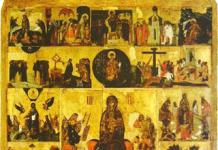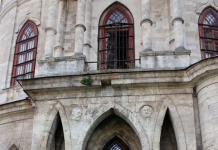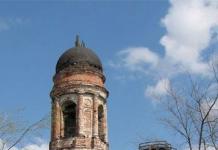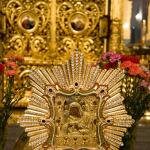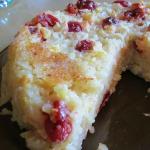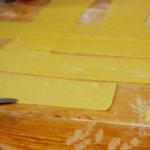Cathedral of the Transfiguration on Bor in the Moscow Kremlin. The oldest stone church in Moscow, founded in 1330 by Prince John Danilovich Kalita. Dismantled in 1933 to create in its place an extension to the Kremlin Palace with service premises (storage for brooms and shovels).
Church of the Annunciation of the Blessed Virgin Mary in the Moscow Kremlin. Built in 1731 at the expense of the government quartermaster's office. Dismantled in 1932.
Church of Constantine and Helena in the Moscow Kremlin. Founded by Vel. book Demetrius Donskoy between 1362 and 1367 In 1651, instead of a wooden one, a stone one was erected at the expense of boyar Ilya Miloslavsky. Destroyed in 1928.
Church of Peter and Paul in the Small Nicholas Palace in the Moscow Kremlin. The palace was built by the architect Kazakov in 1776. The iconostasis of the church was broken at the end of 1922 due to the adaptation of part of the palace to a club for employees of the All-Russian Central Executive Committee and the Council of People's Commissars. The palace is known to the Soviet public from V. Veresaev’s compilation book “Pushkin in Life,” in which an excerpt from P.V. is given on the first page. Annenkov about Pushkin’s arrival from exile to Moscow at the invitation of the emperor in the early autumn of 1826: “The Chudov or Nicholas Palace was then occupied by the august family and the Emperor himself, to whom Pushkin was immediately introduced, in a traveling suit, as he was, not quite warmed up , tired and, it seems, not entirely healthy." Completely destroyed along with the palace in 1929.
Miracles (male) monastery in the Moscow Kremlin. Founded by Saint Alexy Metropolitan. Moscow in 1365. The monastery had 4 churches with 7 altars: the Temple of the Miracle of Archangel Michael, the Cathedral Church of Metropolitan. Alexia, Church of St. Apostle Andrew the First-Called, Church of Joasaph of Belgorod. Completely destroyed (exploded) with all churches and altars in December 1929. In the photo: Metropolitan Alexy Cathedral and the building where the Church of St. Andrew the First-Called was located, 1882. (Naidenov N.A. Moscow. Cathedrals, monasteries and churches. Part I: The Kremlin and Kitai-Gorod. M., 1883, No. 7)
Cathedral Church of the Miracle of the Archangel Michael. The stone one was erected on the site of a wooden one, presumably built in 1358, in 1501 (consecrated in 1503). After the fire of 1626, a new iconostasis was built. It was restored in 1849 under the supervision of Academician Bykovsky. The cellars under the temple are white stone, two-story, with separate entrances.
Cathedral of the Ascension of the Lord of the Ascension Monastery in the Moscow Kremlin. It was erected by the architect Aleviz in 1519 on the site of an old church built in 1467. The last building was built by 1588 by the Tsarina Irina (Godunova) as a replica of the Arkhangelsk Cathedral, since kings were buried in Arkhangelsk, and queens were buried in this one. Side chapels: 1). Dormition of the Blessed Virgin Mary (from the North), 2). Icons of the Mother of God “Joy of All Who Sorrow” (predated in 1732, from the South). Destroyed (exploded) in 1929. In the photo: Ascension Cathedral, early drawing. XIX century. Exploded in December 1929. From a complaint from employees of the Center. state restoration workshops dated December 17, 1929: “We, the undersigned... came to work at 9 o’clock and found the temple blown up and representing a pile of construction waste. Left on the scaffolding the day before... two frescoes of saints in circles had just been removed from the altar apse and covered with plywood were not found..." In the photo: Miracle Monastery in the Moscow Kremlin. Cathedral Church of the Miracle of the Archangel Michael. On the left is the Bell Tower, under which the Church of Joasaph of Belgorod was located (also blown up), 1882. (Naidenov N.A. Moscow. Cathedrals, monasteries and churches. Part I: The Kremlin and Kitai-gorod. M., 1883, N 7A)
Ascension (nunnery) monastery in the Moscow Kremlin. Founded led. Prince, wife of Dmitry Donskoy in 1387. The monastery had 3 churches with 8 altars: the Cathedral of the Ascension of the Lord, the Church of Mikhail Malein, the Church of the Grand Martyr. Catherine. Catherine's Church. Kamennaya has been known since 1517, then, after the Napoleonic invasion, it was dismantled. The last building was built according to the design of the architect Rossi in 1817 in the “Gothic” style. Side chapels: 1). Kazan Icon of the Mother of God, 2). Nativity of John the Baptist. At the end of the 19th century it was updated, marble iconostases appeared in the main altar and chapels. Completely destroyed with all temples and altars in 1929. In the photo: Ascension Monastery in the Moscow Kremlin. Catherine's Church. On the right is the Church of Mikhail Malein (exploded at the same time), 1882. (Naidenov N.A. Moscow. Cathedrals, monasteries and churches. Part I: The Kremlin and Kitai-Gorod. M., 1883, No. 8)
Kazan Cathedral. Built of wood with the contribution of the prince. Dmitry Pozharsky in the 1620s. It burned down in 1635; the Tsar allocated bricks from the palace under construction in the Kremlin for restoration. The main altar was consecrated in 1635, the chapel of Averky of Hierapolis - in the fall of 1637. In 1805, a new bell tower was built on the site of the previous one. He was injured in the explosion of the Nikolskaya Tower by the French hordes. In 1865, the bell tower became three-tiered.
Closed in 1930, allegedly at the request of the Historical Museum. Destroyed in 1936. In 1937, on the site of the Cathedral, there was the B. Iofan Pavilion in honor of the Third International and a toilet for visitors to the pavilion. After V.O.V. on the site of the Cathedral there is only a toilet, which served tourists arriving to gaze at Red Square until the end of the 1980s.
In the 1990s, it was rebuilt from reinforced concrete in imitation of the style of the 17th century.
Cathedral of St. Nicholas the Wonderworker of the St. Nicholas Greek (monastery) (Nikolskaya Street).
Built in 1727. Consecrated in 1736. In the background on the right you can clearly see the Bolshoi Theater, destroyed in the early 2000s by Luzhkov's "reconstructions". Now on the site of the Bolshoi Theater there is a reinforced concrete remodel.
The Cathedral of St. Nicholas the Wonderworker was broken in 1935.
Trinity Church in the Fields. First mentioned in the so-called. "Nikon" chronicle approx. in 1493. It was rebuilt several times (last time - in 1832).
It was destroyed in 1934, and the monument to the first printer Ivan Fedorov (1909), which had stood nearby until then, was moved in its place.
Church (icons) of the Vladimir Mother of God (Nikolskaya Street). Built at the expense of Tsarina Natalya Kirillovna in 1691-1693. Closed in the fall of 1932, demolished in 1934 along with the bell tower, the tower of the Vladimir Gate (visible behind the church) and the adjacent wall of Kitay-Gorod.
Church of St. Nicholas the Wonderworker Big Cross (Ilyinka Street). Mentioned in the Degree Book of the 16th century, between 1680 and 1697. built of stone by the Arkhangelsk merchants Filatyevs.
Demolished in 1933.
Church of the Holy Martyr Hypatia of Gangrsky (Ipatievsky lane). Known since 1472. Stone was built in 1652 at the expense of F.N. Olyabyeva.
It was gradually destroyed since 1929. The former altar apse, used by janitors to store equipment, was destroyed in 1967.
Church of St. Nicholas the Wonderworker "Wet". Mentioned in chronicles since 1468. The last stone building was built in 1697.
Closed in 1932. They demolished it along with the rest of the buildings of the old Zaryadye in the 1930-60s (the part of the Kitay-Gorod wall facing the embankment was blown up in 1951). In 1967, on the site of Zaryadye, the Rossiya Hotel was erected (the shape is a multi-story rectangular parallelepiped made of reinforced concrete panels), the remains of which remain uncleaned to this day (destroyed during the later Luzhkov rule).
Church of St. Nicholas the Wonderworker "Moskvoretsky". Mentioned since the 16th century. rebuilt in 1829 (consecrated in 1832).
It was dismantled, like the entire even side of Moskvoretskaya Street (the only street in Moscow on which there is now not a single building!), in 1936-37. during the construction of the new Moskvoretsky Bridge. Since then, on the site of the church there is a passage to the bridge from Red Square.
From the collection of Yuri Eliseev
Fully here:
As part of anti-religious propaganda in the USSR, a campaign was carried out for the mass destruction of religious objects, in particular churches. The main target of persecution was the Russian Orthodox Church. Our review contains photographs of 13 destroyed churches from different parts of Russia.
In 1914, in the territories of the Russian Empire, according to official data, there were 54,174 Orthodox churches (including monastic, house, cemetery, inactive and assigned, but excluding military churches), 25,593 chapels, 1,025 monasteries. In 1987, there were 6,893 Orthodox churches and 15 monasteries in the USSR. These data refer to the existing churches and monasteries that survived as of 1987. Since a huge number of religious buildings were converted into museums, warehouses, cultural centers (and even apartments), it is extremely difficult to establish the exact number of destroyed (that is, blown up or dismantled) churches.
1. Church of Antipius of Pergamon

It was built at the end of the 18th - beginning of the 19th centuries with the help of the Rybnikov merchants instead of a wooden cemetery. In 1930, the church was closed and began to be used as a warehouse. The temple was returned to believers in 1999, but active renovation work has not yet begun.
2. Church of the Archangel Michael

3. Vvedenskaya Church

The church was built in 1910 and ceased to function in 1930.
4. Temple of Demetrius of Thessalonica

Temple of Demetrius of Thessalonica in the village of Shimonovo The village of Shimonovo is located in the Mozhaisk district on the very edge of the Moscow region. A brick rotundal church in the classicist style, repeating the Moscow temple of Cosmas and Damian on Maroseyka, was erected here in 1801-1805. Almost nothing is known about the fate of the village itself, as well as about the Temple during Soviet times. After the events of 1917, the temple was closed, the bell tower was dismantled.
In the post-perestroika years, the village was almost completely depopulated. The temple is in disrepair: the altar (the main altar, the Demetrius throne) has been dismantled, the interior decoration has been lost, the roof of the refectory has collapsed. However, if you look closely, you can really discern in the outlines of the ruins the resemblance to the Moscow Temple on Maroseyka.
5. Church of the Assumption of the Blessed Virgin Mary

6. Church of the Nativity of the Mother of God

Church of the Nativity of the Mother of God in the village of Verkhovlyany - a stone church in the eclectic style using motifs of ancient Russian architecture was built here in the late 19th - early 20th centuries. Not far from it, on the southern side of the village, there was a manor (of which part of the park remains) and a wooden church of the 18th century. In the 1930s The church was closed, a tractor repair room was set up in it, and later the southern and northern walls were destroyed. To this day it remains in ruins.
7. St. Nicholas Church

St. Nicholas Church in Lytkarino is the oldest church in the area, built in the 1680s. Currently located on the territory of the Petrovskoye estate, which is also empty. During the years of Soviet power, the temple suffered greatly. The interior of the temple was lost and the tent was destroyed. In the 1970s, its restoration began, which was entrusted to V.V. Kavelmacher.
Over the years, the tent was restored, the window casings were renewed, and a three-bay belfry was erected above the entrance. The Petrovskoye estate itself is located on the high bank of the Moscow River. Now all that remains of it are the ground and first white stone floors, above which a second brick floor was built in 1959, the remains of a park and a chain of ponds.
8. Abandoned temple of the Kazan Icon of the Mother of God

An unusual majestic temple, the construction of which began in 1780 opposite the estate gates of the estate of Count Chernyshev. The stone temple was built over 50 years and was a beautiful example of classicism in architecture. The current state of the building is the result of the closure of the temple in 1962 and its use as a utility room. You can get here freely before it finally turns into romantic ruins
9. Church of the Nativity

The former village of Ilkoldino was located in a very picturesque place, five miles from the confluence of the Poli River into the Klyazma. The ancient Vladimirsky highway, which at one time was very busy, passed through the village. The stone church in the village was erected in the mid-19th century. Brick with white stone details, the whitewashed church was designed in the style of late classicism.
The church was closed in the 1930s, and in 1953 the surrounding village was also deserted: due to the allocation of land for the Kosterevsky military training ground, all its residents were forced to move to other places. Now the location of the former village is guessed only by the presence of “cultivated” trees - poplars, bird cherry and lilac bushes, and the church slowly but inexorably continues to collapse.
10. Church of the Intercession of the Mother of God

A white-stone, single-domed church with rich decorative decoration, built in 1762 in the Baroque style. At the end of the 19th century, a brick refectory, a chapel and a bell tower were added to it. During Soviet times, the temple was closed. Priest Mikhail Alekseevich Uspensky was arrested and shot - many years later, in 2000, he was given the title of Hieromartyr. The church was returned to believers in 1993, but active repairs never began.
11. St. Nicholas Church in Lytkarino

12. Church of the Nativity
Church of the Nativity of Christ on White Lake in the village of Krokhino.13. Church of the Savior Not Made by Hands

Church of the Savior Not Made by Hands in the former village of Sergino (the village no longer exists). The temple was built in 1897; the iconostasis was painted by the artist Shishkin. During Soviet times, the temple was closed and looted.
The USSR was created by the Bolsheviks in 1924, on the site of the Russian Empire. In 1917, the Orthodox Church was deeply integrated into the autocratic state and had official status. This was the main factor that most worried the Bolsheviks and their attitude towards religion. They had to take complete control of the church. Thus, the USSR became the first state, one of whose ideological goals was the elimination of religion and its replacement with universal atheism.
The communist regime confiscated church property, ridiculed religion, persecuted believers, and promoted atheism in schools. We can talk about the confiscation of property of religious organizations for a long time, but a frequent result of these confiscations is illegal enrichment.
Confiscation of valuables from the tomb of Alexander Nevsky.

Trial of a priest

Church utensils were broken

Red Army soldiers take church property out of the Simonov Monastery at a subbotnik, 1925.

On January 2, 1922, the All-Russian Central Executive Committee adopted a resolution “On the liquidation of church property.” On February 23, 1922, the Presidium of the All-Russian Central Executive Committee published a decree in which it ordered local Soviets “... to withdraw from church property transferred for the use of groups of believers of all religions, according to inventories and contracts, all precious objects made of gold, silver and stones, the withdrawal of which cannot significantly affect the interests of the cult itself, and transfer it to the People’s Commissariat of Finance to help the starving.”

Religion readily dresses itself in the patterned garments of art. a temple is a special type of theater: the altar is a stage, the iconostasis is decoration, the clergy are actors, the service is a musical play.

In the 1920s. Temples were closed en masse, refurbished or destroyed, shrines were confiscated and desecrated. If in 1914 there were about 75 thousand active churches, chapels and houses of worship in the country, then by 1939 there were about a hundred of them left.

Confiscated miters, 1921

In March 1922, Lenin wrote in a secret letter to members of the Politburo: “The confiscation of valuables, especially the richest laurels, monasteries and churches, must be carried out with merciless determination, certainly stopping at nothing and in the shortest possible time. The more representatives of the reactionary bourgeoisie and the reactionary clergy we manage to shoot on this occasion, the better.”



Arrested priests, Odessa, 1920.

In the 1920s and 1930s, organizations such as the League of Militant Atheists were active in anti-religious propaganda. Atheism was the norm in schools, communist organizations (such as the Pioneer Organization), and the media.


The Resurrection of Christ was celebrated with raids and dances in churches, and believers organized “hot spots” and confessed in letters. If religion is opium, then Easter is its superdose, the Soviet government believed, not allowing the people to celebrate the main Christian holiday.

The fight against the church in the Union took billions of rubles, tons of paper reports and an immeasurable number of man-hours. But as soon as the communist idea failed, Easter cakes and krashenki immediately came out of hiding.
Of the many vacated churches, clubs were set up in larger spaces. According to the historian, there were cases when young people could not bring themselves to go there for parties, and then local functionaries literally forced the girls to dance in the church in the presence of the party leader. Anyone who was noticed at an all-night vigil or wearing paint could be kicked out of work or expelled from the collective farm, and the family would have a hard time. “The fear was so ingrained that even the kids were cautious and knew that they couldn’t talk about baking Easter cakes at home.

In 1930, the Easter holiday was moved from Sunday to Thursday, so that the holiday became a working day. When this practice did not take root, the townspeople began to be driven out to Lenin’s subbotniks, Sundays and mass processions with stuffed priests, which were then burned. According to Olesya Stasiuk, anti-Easter lectures were dedicated to this day: children were told that Easter festivities breed drunkards and hooliganism. Collective farm brigades tried to send them to work further out in the fields, and children were taken on field trips, for ignoring which parents were called to school. And on Good Friday, a time of deep sorrow for Christians, they liked to organize dances for schoolchildren.

Immediately after the revolution, the Bolsheviks began vigorous activity to replace religious holidays and rituals with new, Soviet ones. “The so-called red christenings, red Easters, red carnivals (those with the burning of effigies) were introduced, which were supposed to distract people from traditions, have a form and ideological content that was understandable to them,” says religious scholar Viktor Yelensky. “They relied on Lenin’s words that the church replaces theater for people: they say, give them performances, and they will accept Bolshevik ideas.” Red Easters, however, only existed in the 20s and 30s - they were too much of a mocking parody.

In the late 40s, families still kept pre-holiday preparations a secret. “When the religious procession left the church at midnight, they were already waiting for it: teachers were looking for schoolchildren, and district representatives were looking for the local intelligentsia,” he gives an example from the testimonies of participants in those events. “We learned to confess in absentia for the holiday: a person passed a note with a list of sins to the priest through his messengers, and he released them in writing or imposed penance.” Since there were only a few functioning churches left, going to the all-night vigil turned into a whole pilgrimage.
“From the report of the Commissioner of the Supreme Council for Religious Affairs in the Zaporozhye region B. Kozakov: “I had a chance to observe how, on a dark night under a downpour, at a distance of almost 2 km to the Great Khortytsia Church, old people were literally making their way in the mud and swamp with baskets and bags in their hands . When they were asked why they were torturing themselves in such bad weather, they answered: “It is not torment, but joy - to go to church on Holy Easter...”.

There was a surge in religiosity during the war, and oddly enough, citizens were almost not persecuted. “Stalin, in his speech in connection with the beginning of the Great Patriotic War, even addressed the people in a church manner - “brothers and sisters!” And since 1943, the Moscow Patriarchate has already been actively used in the foreign political arena for propaganda,” notes Viktor Yelensky. Aggressive ridicule and burning of effigies were rejected as too brutal, believers were given a sort of ghetto to quietly celebrate the holiday, and the rest of the citizens were planned to be unobtrusively occupied during Easter days.
Crazy amounts of money were allocated for atheistic propaganda in the USSR; in each district, responsible people reported on the anti-Easter measures taken. In typical "council" fashion, they were required to keep church attendance lower each year than the previous year. They especially pressed on Western Ukraine. We had to take data out of thin air, and it happened that the Donetsk region showed almost three times the percentage of baptized children than the Ternopil region, which is impossible by definition.”

To keep people at home on the holy night, the authorities gave them an unheard-of gift - they gave television concerts “Melodies and Rhythms of Foreign Pop” and other rarities. “I heard from my elders: they used to put an orchestra at the church at night and play obscene performances, making deacons and priests look like drunkards and money-seekers,” says Nikolai Losenko, a native of the Vinnitsa region. And in the native village of the priest’s son Anatoly Polegenko in the Cherkasy region, not a single all-night vigil was complete without a musical background. In the center of the village, the temple was adjacent to the club, and as soon as the parishioners came out with the procession, cheerful music thundered louder than ever at the dances; When we came back, the sound was muffled. “It got to the point that before Easter and for a week after, my parents didn’t keep eggs in the house at all - neither raw, nor boiled, nor white, nor red,” says Polegenko. “Before the war, my father was forced to go further into the field and sing Easter chants alone.”

Closer to perestroika, the regime's fight against religion became profanation. Adequate “controllers” did not punish anyone, but played their role to the end. “The teachers talked about the “priest’s darkness” purely for formality; they could only scold them in a fatherly way for coloring,” says Losenko. “They and the chairman, together with the village council, baked Easter cakes and baptized children, they just didn’t advertise it.”
1961 Trial of believers
The merciless and senseless destruction of the historical buildings of the center of Moscow, famous for its churches and monasteries, began even before the adoption in 1935 of the so-called General Plan, a document openly aimed at the total destruction of Moscow.
Temple of Boris and Gleb, at the Arbat Gate
One of the first to be demolished in 1930 was on Vozdvizhenka at the Arbat Gate. Its slender tent and bell tower were erected according to the design of one of the best architects of that time, Karl Blank, and it was consecrated on December 6, 1768.
The temple of the passion-bearing princes Boris and Gleb was very famous among Muscovites; it housed a large and ancient temple icon of saints with their lives, especially revered by believers - prayer services were often performed in front of it.
The scientist and architect P. D. Baranovsky fought to “preserve the life” of the temple. At a meeting of architects and restorers of the Central State Historical Museum on October 16, 1929, chaired by P. D. Baranovsky, the following unequivocal protest decision was made, which is worth quoting in full:
“To confirm that the building of the Church of Boris and Gleb, designed by the architect Blank, is an 18th-century monument of outstanding historical and architectural significance, both in its strictly consistent forms and external treatment, and in its internal design that corresponds to the external appearance. To note the expediency in terms of unloading the area - the demolition of the two-story building located on it, which has no historical or artistic significance. Summarizing all of the above, we recognize the destruction of a valuable and well-preserved monument as completely unfounded and inappropriate, and therefore consider it necessary to take measures to preserve it.”
In November, workers came to begin dismantling the temple; the architect-restorer B.N. Zasypkin and his students managed to take its measurements. Another page has disappeared from the “stone chronicle” of Moscow...
It was decided to restore the memory of the temple only at the end of the 20th century. Almost in the same place where the temple once stood, a memorial sign was erected, then a little further away it was decided to build a new small, chapel-sized church of Saints Boris and Gleb. The first stone of the reconstructed temple was laid on May 8, 1997 on Arbat Square, not far from the lobby of the Arbatskaya metro station.
Church of St. Tikhon, Bishop of Amafuntsky
At this place, not far from the Church of Saints Boris and Gleb, there was a church, which was also blown up in 1933.
“The place that was chosen for the chapel,” said the author of the project, architect Yuri Semenovich Vylegzhanin, “is twice holy, previously there was a demolished church of St. Tikhon. And it was decided, by recreating the chapel of Boris and Gleb, to somehow preserve the memory of this destroyed temple. Therefore, one of the chapel's aisles was consecrated in honor of St. Tikhon. The size of the chapel has increased, it has become a church-chapel, where services are now held regularly.”
The newly built church-chapel was assigned to the Great Ascension Church; Patriarch Alexy of Moscow and All Rus' consecrated it in the name of the holy noble princes and passion-bearers Boris and Gleb on August 6, 1997.
Church of Boris and Gleb
Another Church of Boris and Gleb, built in 1635, stood on the site of the current concert hall of the Russian Academy of Music. Gnessins in Borisoglebsky Lane, demolished in the same 1933.
A prayer service at the memorial sign on the site of the destroyed temple and its consecration was performed on November 15, 2007 by the cleric of the Great Ascension Church, Archpriest Vladimir Antonov.
“Now in this place,” said the priest, “there is another building, but we still show that we remember those shrines that the Russian people built in honor of the patrons of our land and those who prayed for us.”
The Temple of Boris and Gleb was famous for the fact that it housed the icon of the Savior Not Made by Hands, painted by Simon Ushakov.
This temple gave the name to the existing Borisoglebsky Lane.
Among the famous parishioners of the Boris and Gleb Church on Povarskaya was the Chief Prosecutor of the Holy Synod, K. P. Pobedonostsev, who read the Apostle in it during services.
Temple of the Wonderworker Spyridon of Trimifuntsky on the Goat Swamp
Near the Church of the Ascension of the Lord at the Nikitsky Gate there is Spiridonovka Street and Spiridonievsky Lane. They got their name from the temple of the wonderworker Spyridon of Trimifuntsky on the Goat Swamp; it was built by His Holiness Patriarch of Moscow and All Rus' Filaret (Fyodor Nikitich Romanov). The temple was first mentioned in 1627; it was the only temple in Moscow consecrated in honor of this saint.
During the atheistic period, the temple was destroyed to the ground. P.D. fought to save the temple of the wonderworker Spyridon. Baranovsky, but, like the temple of Boris and Gleb, could not defend it.
The memory of the wonderworker Spyridon and his destroyed temple is preserved in the Great Ascension Church, where there is a large icon of the saint.
Church of the Holy Martyrs Sophia and Tatiana
The clergy of the “Great Ascension” also take care of the Church of the Holy Martyrs Sophia and Tatiana, which is located on the territory of the first children’s hospital in Moscow named after N. F. Filatov. The hospital was established under the governor, Prince Dmitry Vladimirovich Golitsyn, and the temple was consecrated in honor of the heavenly patroness of the governor’s wife, Princess Tatiana Vasilievna Golitsyn.
The governorship of Prince Golitsyn became one of the happiest for Moscow. His wife, Princess T.V. Golitsyna, née Vasilchikova, started a tradition according to which charity became, as they say, “good manners” for the ladies of the city. She believed that “being useful to others is the only justification for our earthly existence.” The first charitable societies appeared in Moscow, and several large city hospitals were built: 1st Gradskaya, Glaznaya and Novo-Ekaterininskaya.
In 1841, Princess Tatiana Vasilievna Golitsyna died, grief-stricken Prince Dmitry Vasilyevich honored her memory by establishing a children's hospital with a house church of the holy martyr Tatiana, which was consecrated on December 5, 1842 by Metropolitan Philaret of Moscow.
In 1843, as Governor-General of Prince D.V. Golitsyn was replaced by Prince A.G. Shcherbatov. His wife, Princess Sofia Stepanovna Shcherbatova, née Apraksina, was Prince Dmitry Vasilyevich’s niece and had seen examples of charity since childhood. In 1848, Prince Shcherbatov became seriously ill and died, and his widow, Princess Sofia Shcherbatova, devoted herself entirely to charity. Even earlier, at the prompting of Dr. Haas, the princess organized the first Nikolaev community of sisters of mercy in Moscow, who cared for the sick.
In 1858, Princess Sofia Shcherbatova bought a plot of land on Sadovo-Kudrinskaya Street. When she died, her son, Alexander Alekseevich, on behalf of his brothers and sisters, addressed the Board of Trustees with a request to accept this plot as a gift.
The donors set the following conditions: the property should be directly occupied by the hospital, no temporary or permanent extraction of income from the land should be allowed, the hospital should be called Sophia, a church should be built in the name of St. Tatiana, as in the hospital on Malaya Bronnaya, and St. Sophia.”
The new hospital buildings were built in 1892-1897 by the architect A. S. Kaminsky, and according to his design, a temple was built in the center of the hospital in a style called “pseudo-Byzantine”. The temple and hospital were consecrated on November 12, 1897.
During Soviet times, the crosses were removed from the temple, then the dome was demolished. A morgue was set up in the temple, for which it was rebuilt beyond recognition.
At the end of the 20th century, the temple building began to be restored; a chapel was built in one of the rooms; the remaining premises of the temple were used for the economic needs of the hospital.
In 2008, at the request of the chief physician of the hospital, Professor V.V. Popov, His Holiness Patriarch of Moscow and All Rus' Alexy turned to the mayor of Moscow Yu.M. Luzhkov with a request to recreate the temple of the martyrs Tatiana and Sophia. The temple was transferred to the Russian Orthodox Church in May 2010.
Clergy from the Great Ascension Church provide care for patients and staff at the children's hospital.
Because there was not a single sheep suitable for this purpose in the city. By order of Titus, Yosef ben Matityau [better known as - approx. ed.] informed the Jews [residents of besieged Jerusalem] the will of the Romans - to surrender the Temple without bloodshed. Yohanan [ Yohanan of Gush Halava, who seized power in the city - approx. ed.] answered with a categorical “no.”
And then the battle for the Temple began. Titus intended to capture it at the first attack, but he failed to do so. The Jews fought heroically for every inch of land. However, the Romans were far superior in strength, weapons and military equipment. As soon as one Roman detachment was exhausted, it was immediately replaced by another. The strength of the Jews was limited; they not only had no rest either day or night, but had also been starving for a long time. Gradually, the Romans managed to break through to the buildings surrounding the Temple, and the Jews were forced to concentrate in the courtyard of the Temple itself. As the Jews retreated, they filled these outer rooms with firewood and tar. And when the Romans entered the halls with trumpets and shouts of victory, a fire suddenly broke out in them. Most of the soldiers were burned alive, only a few managed to escape by jumping from the walls of the burning building.
Burning Temple
The stones of the Temple Wall were extremely strong, and the Romans had no way of breaking through them. The soldiers tried to climb the walls using ladders, but the Jews rained down stones and arrows on them. Then Titus ordered the gates of the Temple to be set on fire. The defenders of the Shrine fought with incredible courage. Successive Roman troops moved forward step by step, pushing the Jews inside the Temple.

Moreover, the sages of the Talmud said: “ The generation in which the Temple was not built seems to have destroyed it with its own hands».
In other words, if the Temple has not yet been built, it means that we have not yet corrected the sins that led to its destruction.
The first Temple, which was built by King Shlomo (Solomon), stood for 410 years, from 2928 to 3338 from the creation of the world. The Second Temple stood for 420 years, and after its destruction the Jews went into Galut - the Exile, which continues to this day! This means that the reasons that led to its destruction then are still in effect now. But their correction gives a chance that the presence of the Creator will return to this world.
